Lesson 1 Analog Amplifiers
At the most basic level, a signal amplifier does exactly what you expect – it makes a signal
bigger! However, the way in which it is done does vary with the design of the actual amplifier,
the type of signal, and the reason why we want to enlarge the signal. [1] We can illustrate this by
considering the common example of a “Hi-Fi” audio system.
In a typical modern Hi-Fi: system, the signals will come from a unit like a CD player, FM
tuner, or a Tape/Minidisk unit. The signals they produce have typical levels of the order of
100 mV or so when the music is moderately loud. This is a reasonably large voltage, easy to
detect with something like an oscilloscope or a voltmeter. However, the actual power levels of
these signals are quite modest. Typically, these sources can only provide currents of a few
milliamps, which by P=VI means powers of just a few milliwatts. A typical loudspeaker will
require between a few Watts and perhaps over 100 Watts to produce loud sound. Hence we will
require some form of Power Amplifier (PA) to “boost” the signal power level from the source
and make it big enough to play the music.
Fig. 1.1 shows four examples of simple analog amplifier stages using various types of
device. In each case the a.c. voltage gain will usually be approximated by
Fig. 1.1 Examples of voltage amplifiers
Av≈-R1/R2 (1-1)
provided that the actual device has an inherent gain large enough to be controlled by the resistor
values chosen.Note the negative sign in expression 1-1 which indicates that the examples all
invert the signal pattern when amplifying. [2] In practice, gains of the order of up to hundred are
possible from simple circuits like this, although it is usually a good idea to keep the voltage gain
below this. Note also that vacuum state devices tend to be called “valves” in the UK and “tubes”
in the USA.
�
·2·
自动化专业英语
Many practical amplifiers chain together a series of analog amplifier stages to obtain a high
overall voltage gain. For example, a PA system might start with voltages of the order of 0.1 mV
from microphones, and boost this to perhaps 10 to 100 V to drive loudspeakers. This requires an
overall voltage gain of 109, so a number of voltage gain stages will be required.
In many cases we wish to amplify the current signal level as well as the voltage. The
example we can consider here is the signal required to drive the loudspeakers in a “Hi-Fi” system.
These will tend to have a typical input impedance of the order of 8 Ohms. So to drive, say, 100
Watts into such a loudspeaker load we have to simultaneously provide a voltage of 28 Vrms and
3.5 Arms. Taking the example of a microphone as an initial source again a typical source
impedance will be around 100 Ohms. Hence the microphone will provide just 1 nA when
producing 0.1 mV. This means that to take this and drive 100 W into a loudspeaker the amplifier
system must amplify the signal current by a factor of over 109 at the same time as boosting the
voltage by a similar amount. [3] This means that the overall power gain required is 1018 – i.e. 180
dB!
This high overall power gain is one reason it is common to spread the amplifying function
into separately boxed pre- and power-amplifiers. The signal levels inside power amplifiers are so
much larger than these weak inputs that even the slightest ‘leakage’ from the output back to the
input may cause problems. By putting the high-power (high current) and low power sections in
different boxes we can help protect the input signals from harm.
In practice, many devices which require high currents and powers tend to work on the basis
that it is the signal voltage which determines the level of response, and they then draw the current
they need in order to work. [4] For example, it is the convention with loudspeakers that the
volume of the sound should be set by the voltage applied to the speaker. Despite this, most
loudspeakers have an efficiency (the effectiveness with which electrical power is converted into
acoustical power) which is highly frequency dependent. To a large extent this arises as a natural
consequence of the physical properties of loudspeakers. We won’t worry about the details here,
but as a result a loudspeaker’s input impedance usually varies in quite a complicated manner with
the frequency. (Sometimes also with the input level.)
Fig. 1.2 shows a typical example. In this case, the loudspeaker has an impedance of around
12 Ohms at 150 Hz and 5 Ohms at 1 kHz. So over twice the current will be required to play the
same output level at 1 kHz than is required at 150 Hz. The power amplifier has no way to “know
in advance” what kind of loudspeaker you will use, so simply adopts the convention of asserting
a voltage level to indicate the required signal level at each frequency in the signal and supplying
whatever current the loudspeaker then requires.
This kind of behavior is quite common in electronic systems. It means that, in information
terms, the signal pattern is determined by the way the voltage varies with time, and ideally the
current required is then drawn. Although the above is based on a high-power example, a similar
situation can arise when a sensor is able to generate a voltage in response to an input stimulus but
can only supply a very limited current. In these situations we require either a current amplifier or
·2·
�
Lesson 1 Analog Amplifiers
·3·
a buffer. These devices are quite similar, and in each case we are using some form of gain device
and circuit to increase the signal current level. However, a current amplifier always tries to
multiply the current by a set amount. Hence it is similar in action to a voltage amplifier which
always tries to multiply the signal current by a set amount. The buffer differs from the current
amplifier as it sets out to provide whatever current level is demanded from it in order to maintain
the signal voltage told to assert. Hence it will have a higher current gain when connected to a
more demanding load.
Fig 1.2 Impedance properties of a typical “8 Ohms” loudspeaker
New Words and Phrases
1. analog [5AnElC^]
2. amplifier [5Ampli7faiE]
3. illustrate [5ilEstreit]
4. audio [5C:diEu]
5. Hi-Fi [5hai5fai]
6. fidelity [fi5deliti]
7. minidisk [5minidisk]
8. approximate [E5prCksimeit]
9. provided that
10. of the order of
11. FM
[电工]扩音器,放大器
举例说明,阐明,图解,加插图于
举例
类似物,相似体,模拟量
n.
adj. 模拟的
n.
vt.
vi.
adj. 音频的,声频的,声音的
音响,声音信号
n.
n.
abbr.
n.
hi-fis(收音机、录音机等)具有高保真度
(略语)高保真(High-Fidelity)
忠实,诚实,忠诚,(收音机,录音设备等的)
逼真度,保真度
小型磁盘
n.
adj. 近似的,大约的
vt., vi.
(常与 to 连用)近似,接近
假如,倘若,如果,在……的条件下
大约,左右,约与……相同(似),
达到……数量(= in the order of)
(略语)调频(frequency modulation)
abbr.
·3·
�
·4·
自动化专业英语
12. tuner [5tju:nE]
13. moderately [5mCdEritli]
14. oscilloscope [C5silEskEup]
15. voltmeter [5vEult7mi:tE(r)]
16. milliwatt [5miliwCt]
17. milliampere [7mili5AmpZE]
18. a.c.
19. gain [^ein]
20. voltage gain
21. impedance [im5pi:dEns]
22. resistor [ri5zistE]
23. valve [vAlv]
[物]示波镜,示波器,示波管
调谐器,调谐电路,调音者,定弦者
n.
adv. 适度地,稳健地
n.
伏特计,电压表
n.
毫瓦
n.
n.
abbr.
n.
vt.
n.
n.
n.
[电]毫安培
(略语)交流电(alternating current)
增益,财物的增加,利润,收获
得到,增进,赚到,vi.获利,增加
电压增益
阀,活门,气门,[英]电子管,真空管(心脏)
[电]阻抗,全电阻
[电] 电阻,电阻器
24. tube [5tju:b]
25. bipolar [bai5pEulE]
26. FET
27. J-FET
28. N-channel
29. inverting [in5vE:tiN]
30. boost [bu:st]
31. triode [5traiEud]
32. op-amp
33. current [5kQrEnt]
34. in advance
35. simultaneously
瓣膜,(贝类的)壳瓣
管,管子,[英]地铁,<美>电子管,显像管
(略语)场效应管(Field-effect transistor)
J 型场效应管
N 沟道
n.
adj. 双极的,有两极的,两相的
abbr.
adj. 反相的,倒相的
推进,增加,增进,升压,拔高,改善
vt.
上推,增加,提高,帮助,鼓舞
n.
n.
abbr.
adj. 当前的,通用的,流通的,草写的,最近的
n.
[电子]三极管,真空三极管
(略语)运算放大器(operational amplifier)
涌流,趋势,电流
提前,事前,预先
[simEl5teiniEsly; (?@) saim-]adv. 同时地
36. convention [kEn5venFEn]
n.
大会,会议,协定,条约,协议,契约,
习俗,惯例
37. overall power
38. applied [E5plaid]
39. acoustical [E5ku:stik(E)l]
40. consequence [5kCnsikwEns] n.
总功率
adj. 应用的,实用的,施加的,外加的
adj. 听觉的,声学的
结果,[逻]推理,推论,因果关系,
重要的地位
41. sensor [5sensE]
42. stimulus [5stimjulEs]
43. buffer [5bQfE]
n.
n.
n.
传感器,灵敏元件
刺激,刺激物,促进因素[复数]stimuli
缓冲器,缓冲物,缓冲区
·4·
�
Lesson 1 Analog Amplifiers
·5·
44. in action
45. assert [E5sE:t]
46. Ohm [Eum]
47. Hz
缓冲
在活动,在运转,在工作,起作用,在运行中
断言,声称,主张,维护,表明
vt.
vt.
n. 欧姆(①姓氏 ②Georg Simon,1787—1854,
德国物理学家) [电]欧姆
(略语)hertz [hE:ts]
abbr.
n. 赫,赫兹(频率单位:周/秒)赫兹 ①姓氏
②Gustav, 1887—1975, 德国物理学家,
曾获 1925 年诺贝尔物理学奖
48. demanding
[di5mB:ndiN; (?@) di5mAndiN]adj. 过分要求的,苛求的,费力的,
需要技能的,要求高的
Notes
[1] However, the way in which this is done does vary with the design of the actual amplifier,
the type of signal, and the reason why we want to enlarge the signal.
然而,信号的放大方式随着实际放大器的设计、信号的类型以及放大信号目的的不同
而变化。
本句为强调句型,句中的定语从句 in which this is done 修饰主语 the way,does 用于强
调谓语 vary。短语结构 the design of the actual amplifier 与 the type of signal 及 and the reason
why we want to enlarge the signal 并列作为介词 with 的宾语。why 引导的定语从句修饰 the
reason。
[2] Note the negative sign in expression 1-1 which indicates that the examples all invert the
signal pattern when amplifying.
注意,表达式 1-1 中的负号说明,示例中的电路在放大时改变了信号的极性。
句中 which 引导的定语从句和介词短语 in expression 1-1 修饰动词 Note 的宾语 the
negative sign,that 引导的宾语从句在定语从句中作宾语,副词 all 和分词结构 when amplifying
修饰谓语动词 invert。
[3] This means that to take this and drive 100 W into a loudspeaker the amplifier system
must amplify the signal current by a factor of over 109 at the same time as boosting the voltage
by a similar amount.
这就表示要接受这种输入信号并去驱动 100 瓦的扬声器,放大电路就必须将信号的电
流和电压同时放大 109 倍。
句中 that 引导的从句作谓语动词 means 的宾语,不定式短语 to take…在宾语从句中作
目的状语,by a factor…为从句中的方式状语。
[4] In practice, many devices which require high currents and powers tend to work on the
basis that it is the signal voltage which determines the level of response, and they then draw the
current they need in order to work.
实际上,许多需要大电流和大功率的设备往往都在特定的条件下工作,即由信号的电
·5·
�
·6·
自动化专业英语
压决定响应的幅度,继而由设备吸收其所需要的电流而工作。
句中 which 引导的定语从句修饰主语 many devices,介词短语 on the basis 作状语,that
引导的定语从句修饰 the basis,which 引导的从句定语修饰 the signal voltage,they need 为
省略了关系代词的定语从句,修饰 draw 的宾语 the current。
Translating Skills 科技英语翻译概述
随着科学技术的迅猛发展,新技术、新学科、新材料、新工艺的不断出现,各层次技
术交流的日益频繁,很多用英语撰写的科技文献大量出现。20 世纪 70 年代以来科技英语
在教育领域逐渐成为一种专业,对科技英语的研究也在不断深入,在科技翻译方面出版了
大量的论文、专著,来探讨这种科技英语的翻译理论和翻译方法。科技英语是指科技文体,
包括英语科技论文、科技报告、科普文章、科技新闻和科技产品说明书等与科技有关的各
种文献,它有别于一般英语和文学英语。因此对科技文体的翻译也有别于其他文体的翻译。
要搞好科技英语翻译就要了解科技英语的词汇、语法、句法和特征,熟悉科技英语的思维
翻译过程,掌握科技英语的翻译原则和标准,懂得科技英语的翻译技巧,学习有关的专业
知识,打好扎实的功底。
科技英语文体的特点
1. 词汇特征
科技文体承载着探索自然奥秘,揭示客观事物发展规律的信息,所传递的是客观真理,
客观事实,因此必须使用表意准确的专业术语。专业术语是专业领域的概念名词,来源广
泛,有来源于日常生活的术语词也叫准专业术语,但大量的术语主要来源于希腊语和拉丁
语的词语,因此其词形固定,词义单一,不容易混淆。同时不同领域的科技术语其语义具
有明确的层次结构,简明扼要,相对固定,具有国际通用性。由于希腊语和拉丁语的词缀
丰富,有极强的构词能力,因此以它们为主要来源的科技术语在构词方面也有此特征。如
copper end rings 铜端环(名词+名词),magnetic moment 磁力矩(形容词+名词),alternating
current 交流电(ing 分词+名词),field winding 励磁绕组(名词+ing 名词),output 输出(小品词
+动词),printed circuit 印制电路(ed 分词+名词),I-cursor I 形光标(大写字母+名词),modern
control system 现代控制系统(形容词+名词+名词中心词),autochart 自动流程图(auto 前缀),
speedmeter 速度计(meter 后缀),techicolor 彩色摄影(“i”中缀) 。翻译时把英语和汉语的构词
法和语义特性结合起来,采用音译、意译、形译、象译或音意结合的方法,达到准确、简
洁、通俗易懂。如在翻译 bi-stable circuit 时,结合汉语的四字结构的表达习惯,翻译成“双
稳电路”要比“双稳态电路”简洁。
2. 语法、句法特征
科技文献概括事物发展的规律,陈述客观事实的存在,突出所述事实,因此多使用一
般现在时和被动语态。为了严密表达事物之间的逻辑和先后、主次关系,多使用带有介词
短语、形容词短语、分词短语、不定式短语、同位语从句、定语从句或状语从句等修饰语
的长句。为了叙述方便,常使用以 it 为形式主语的句型。如:
The signal levels inside power amplifiers are so much larger than these weak inputs that
·6·
�
Lesson 1 Analog Amplifiers
·7·
even the slightest ‘leakage’ from the output back to the input may cause problems.
功率放大器中的信号幅度比微弱的输入信号大得多,即使输出的极微小的泄漏传输到
输入端,都会引发一些问题。
For example, it is the convention with loudspeakers that the volume of the sound should be
set by the voltage applied to the speaker.
例如,扬声器的音量通常是受所加电压控制。
科技英语翻译的标准与原则
科技翻译的对象十分广泛,涉及专著、论文、专利说明书、实验报告和会议记录等各
种材料,要想把严谨的英语科技文献准确无误、通顺流畅地翻译成汉语,就要遵循一定的
标准和原则。关于翻译的标准国内外提出了不少理论,国内从严复的“信、达、雅”到鲁
迅的“信、顺”,到茅盾的“意境”,傅雷的“神似”,钱钟书的“化境”;国外的有前
苏联费道罗夫的“等值”理论,美国翻译家尤金·奈达的“语言学-符号学”翻译理论,美
国语言学家 W.Mann 和 S.Thompson 的“语篇分类学说”,韩礼德和哈桑的“衔接”理论。
这些翻译理论在科技英语翻译中也适用。权衡概括这些理论,在科技翻译中有人提出了已
得到公认的两种标准。
1. 忠实原文
指译者把原文所包含的概念、事理、思想、论点、结论、方法,即原作表达的一切信
息包括语言形式、语言意义和思想逻辑忠实、准确地传达出来。
2. 语句通顺流畅、简洁自然,语言通俗易懂、符合译入语规范
由于科技文体重视严密的逻辑性,语言庄重规范,翻译时常采用直译法。但译者一定
要仔细研读原文,不能因拘泥于形式而讲究语法、句子成分和语序的完全对等,致使译文
晦涩难懂。要根据句子内部的逻辑关系和汉语的表达习惯适当调整语序,必要时增加或省
略一些词,用简洁、精炼、通俗易懂的语言再现其思想内容、语体风格和感情色彩。
搞好科技英语翻译应具备的条件
想翻译出一篇好的科技文体的文章来,并不是一件容易的事。仅仅依靠对英语的掌握
或对汉语的文字驾驭能力,都不能搞好科技翻译。因为科技翻译是一个复杂的过程,涉及
多方面的素质,必须综合各方面的因素。
1. 科学严谨的态度
历数翻译界的专家学者所从事的翻译事业,可以看出他们付出了艰辛劳动,耗费了很
多精力,进行了大量实践,呈现给读者一篇篇值得反复阅读的优秀译文,给我们带来知识、
带来美感、带来享受。从中了解到他们严谨的翻译态度。科技翻译必须严肃认真,一丝不
苟,勤查词典,不能想当然的主观猜测。一个词、一个符号、一个数字都须准确理解其作
用、含义。
2. 良好的英语语言基础
熟练掌握英语是进行英汉转换的前提。对英语一知半解,就不能很好地理解原文,更
·7·
�
·8·
自动化专业英语
无从谈起翻译,也就不可能有好的译作。事实证明,没有扎实的英语基础,仅凭词典加翻
译机器加原文是搞不好科技翻译的。
3. 熟练地驾驭汉语的能力
同样,没有熟练地驾驭汉语语言的能力,即使理解得很透彻,翻译出来的文字不是晦
涩难懂,就是语义模糊,也让人似懂非懂。
4. 广博的专业及相关领域的知识
当今科技发展迅速,学科之间交叉渗透普遍,一个领域里会有另外领域的知识。因此,
只有经常学习本专业和相关专业的知识,才能胜任科技翻译。
5. 必要的英语翻译理论和技巧
理论是指导实践的有效工具,有时一个段落、一个句子或一个术语,尽管了然于心,
但往往苦于找不到合适的方法进行翻译,令人非常苦恼。必要理论的知识会使人豁然开朗。
6. 大量实践经验的积累
范武邱先生所编著的《实用科技英语翻译讲评》(P76)中有一句话说得非常好:一般认
为,没有十万字的翻译实践而去谈理论基本上是纸上谈兵,其实用性和可操作性让人生疑。
从中可见翻译实践经验的积累对搞好翻译至关重要。
Exercises
1. Translate the following into Chinese.
(1)A bipolar junction transistor (BJT) is a three-layer silicon (or germanium) device
consisting of either two p- and one n-type layers of materials (pnp) or two n- and one p-type
layers of materials (npn).
(2)Since the emitter follower has a high input impedance and a low output impedance, its
voltage gain is less than unity and the power gain is normally lower than that obtained from other
configurations.
(3)The current in a reverse-biased diode is small (typically 10-8 A for silicon) and
approximately independent of voltage until the breakdown region at high reverse voltages is
reached.
(4) Most integrated circuits provide the same functionality as “discrete” semiconductor
circuits at higher levels of reliability and at a fraction of the cost.
(5) Vision is well developed in most snakes, but many burrowing snakes are virtually blind.
(6) Working out regularly may make you smarter now and lessen the possibility that you
will lose brain function as you age.
(7) They work out a new method by which production has now been rapidly increased.
·8·
�
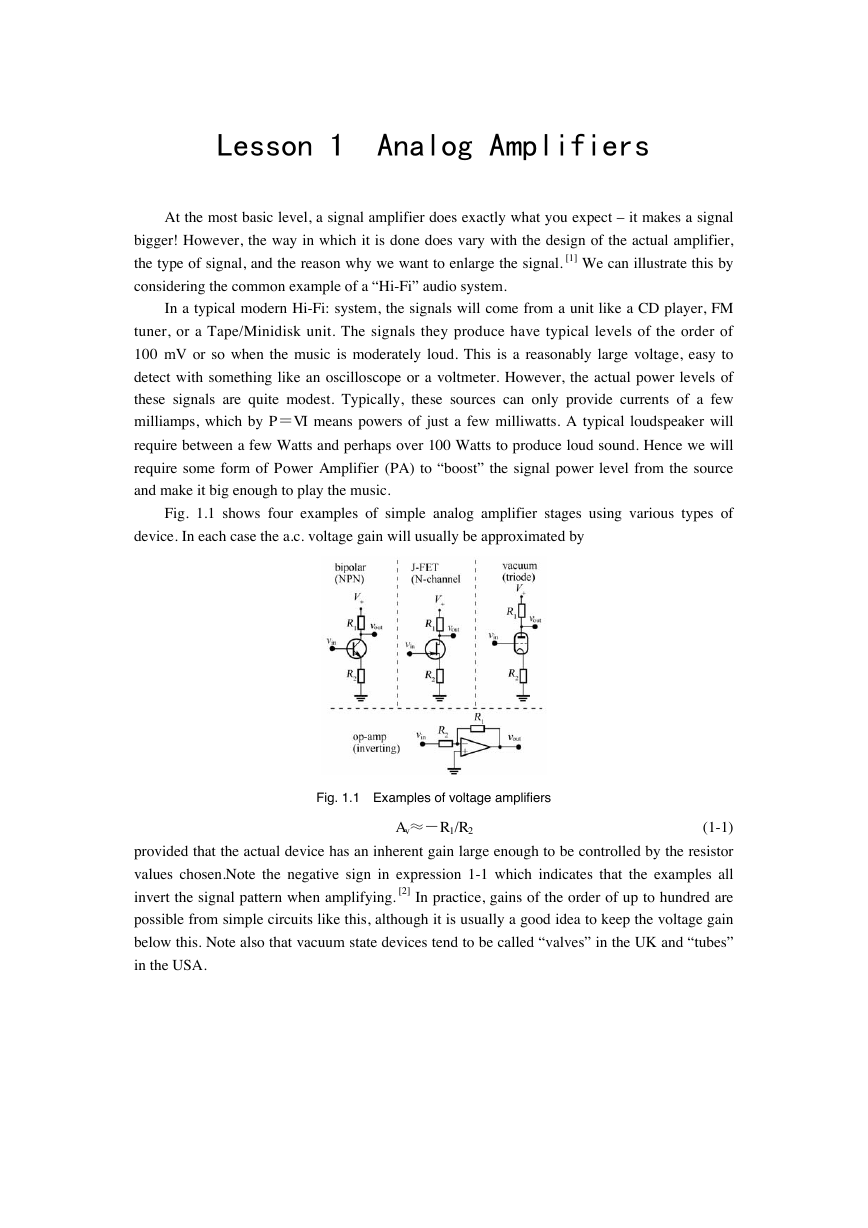
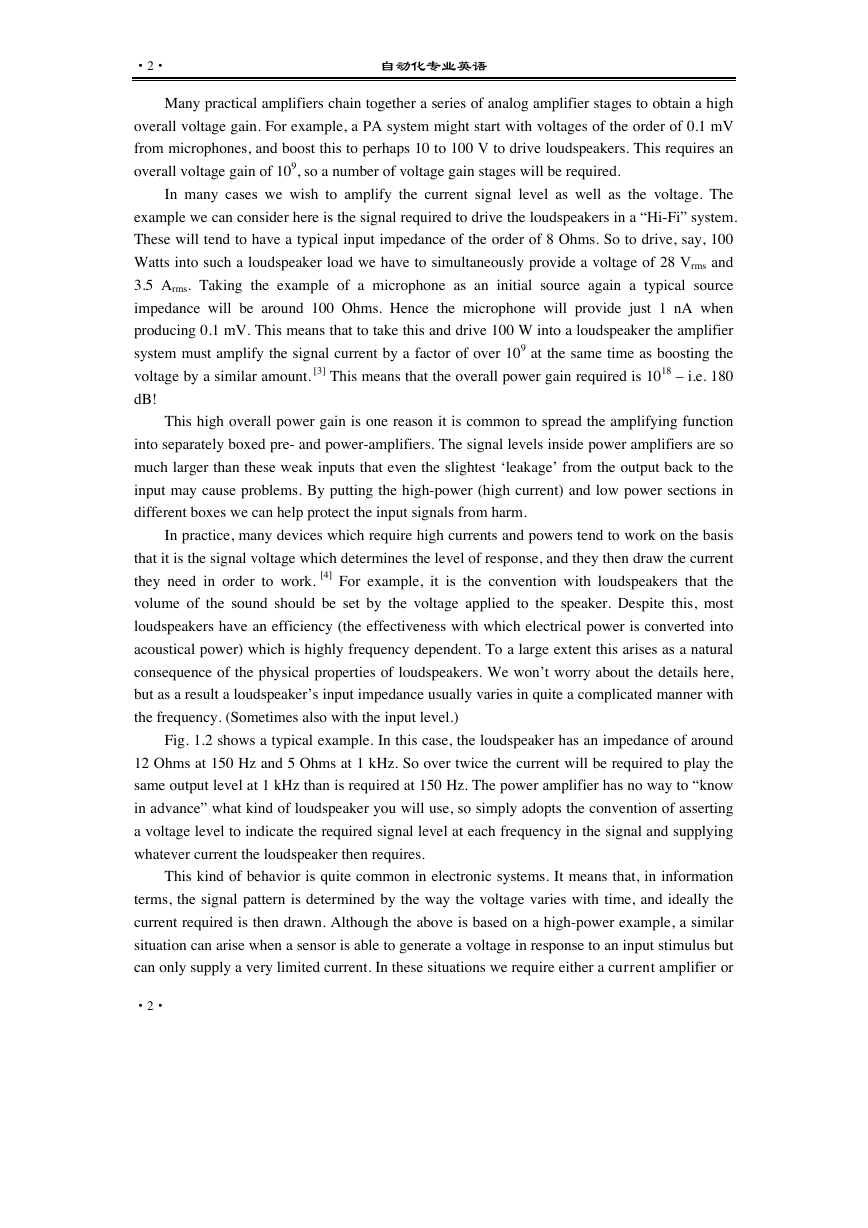
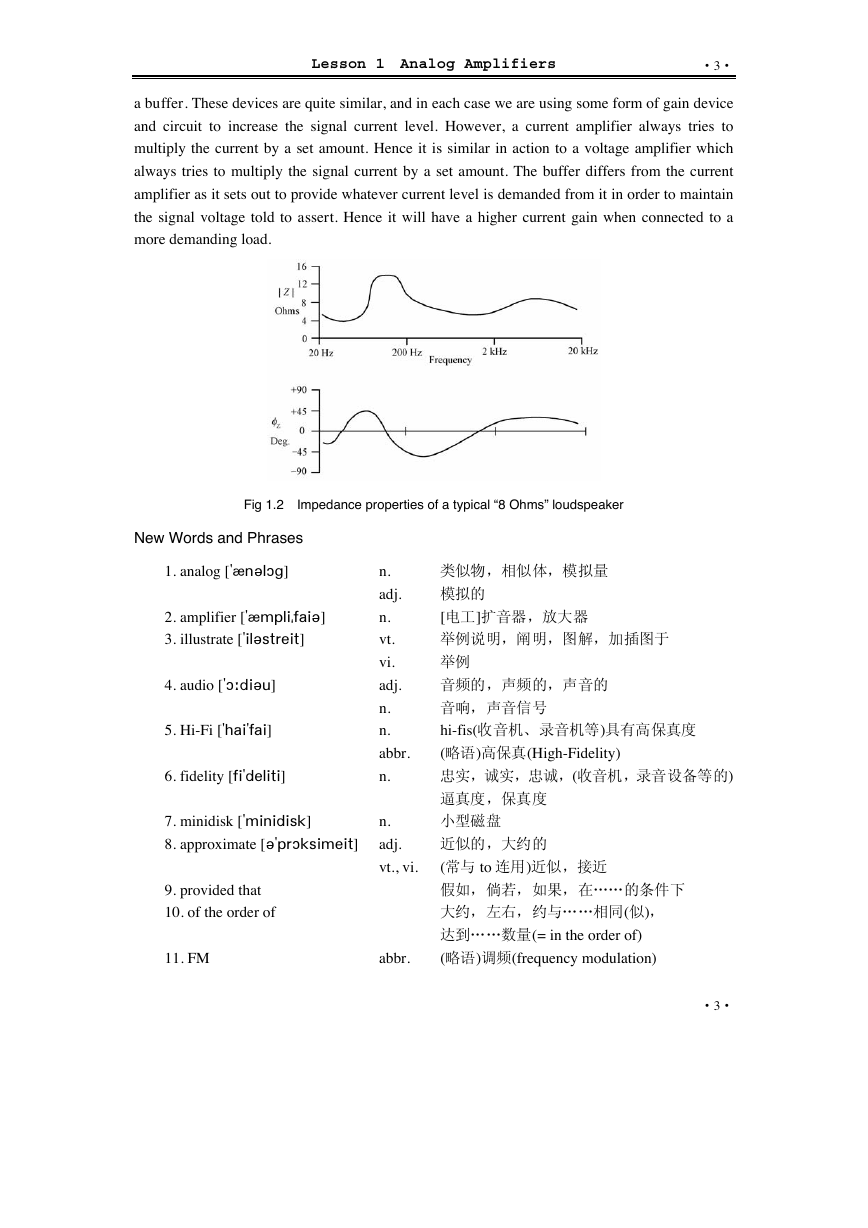
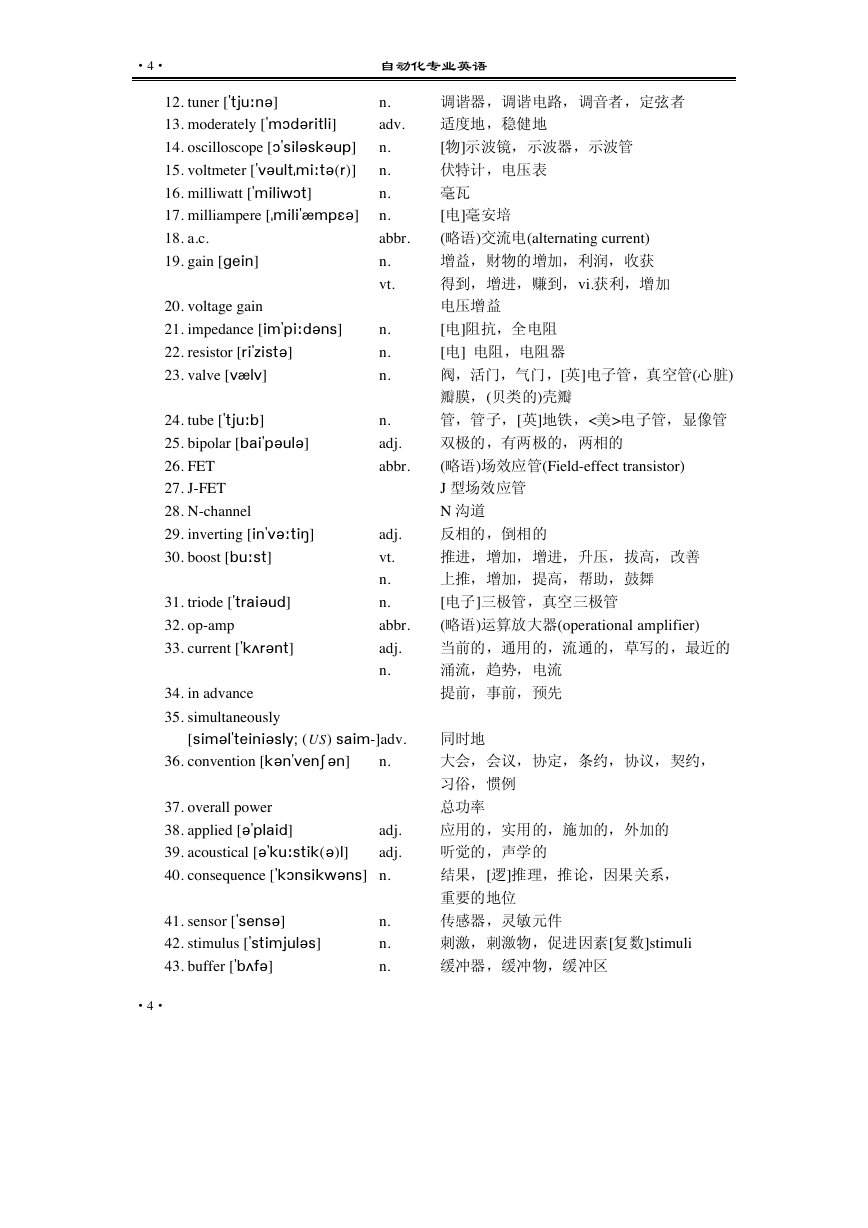
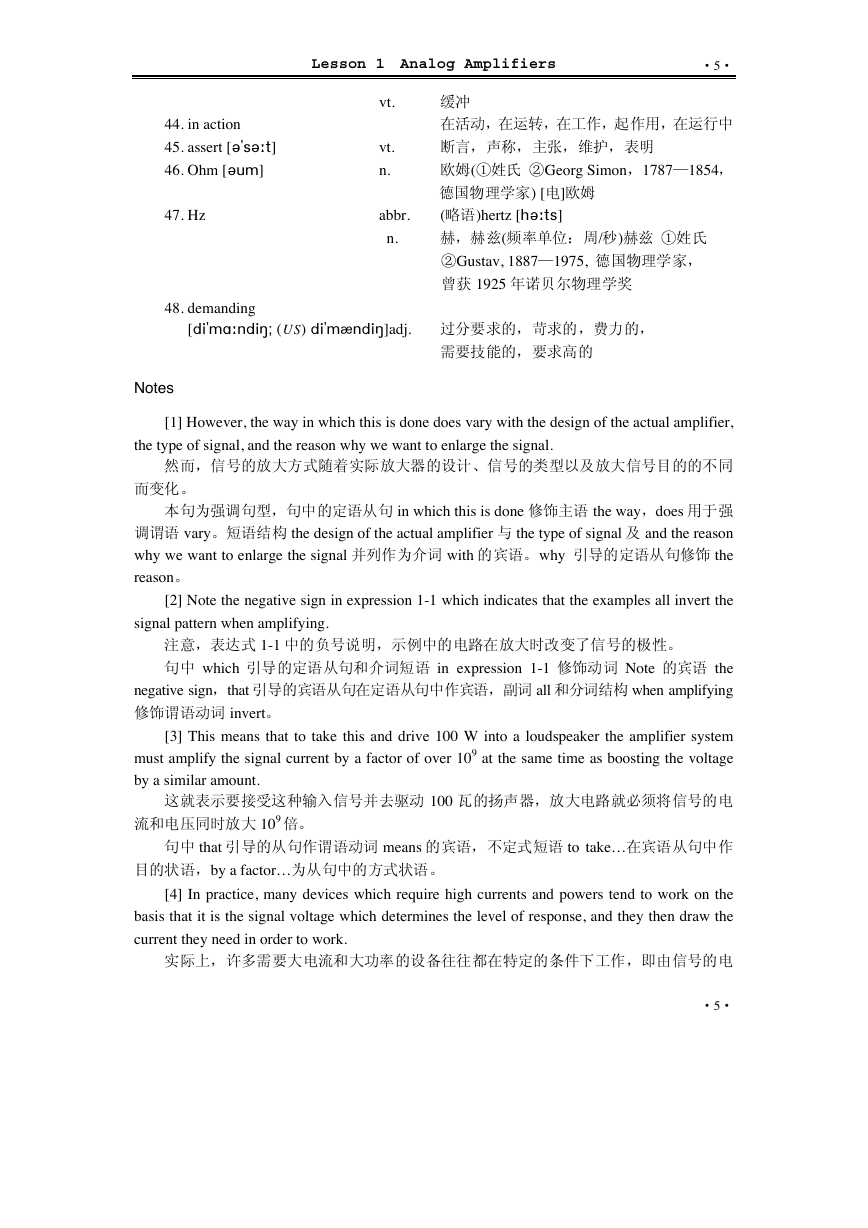
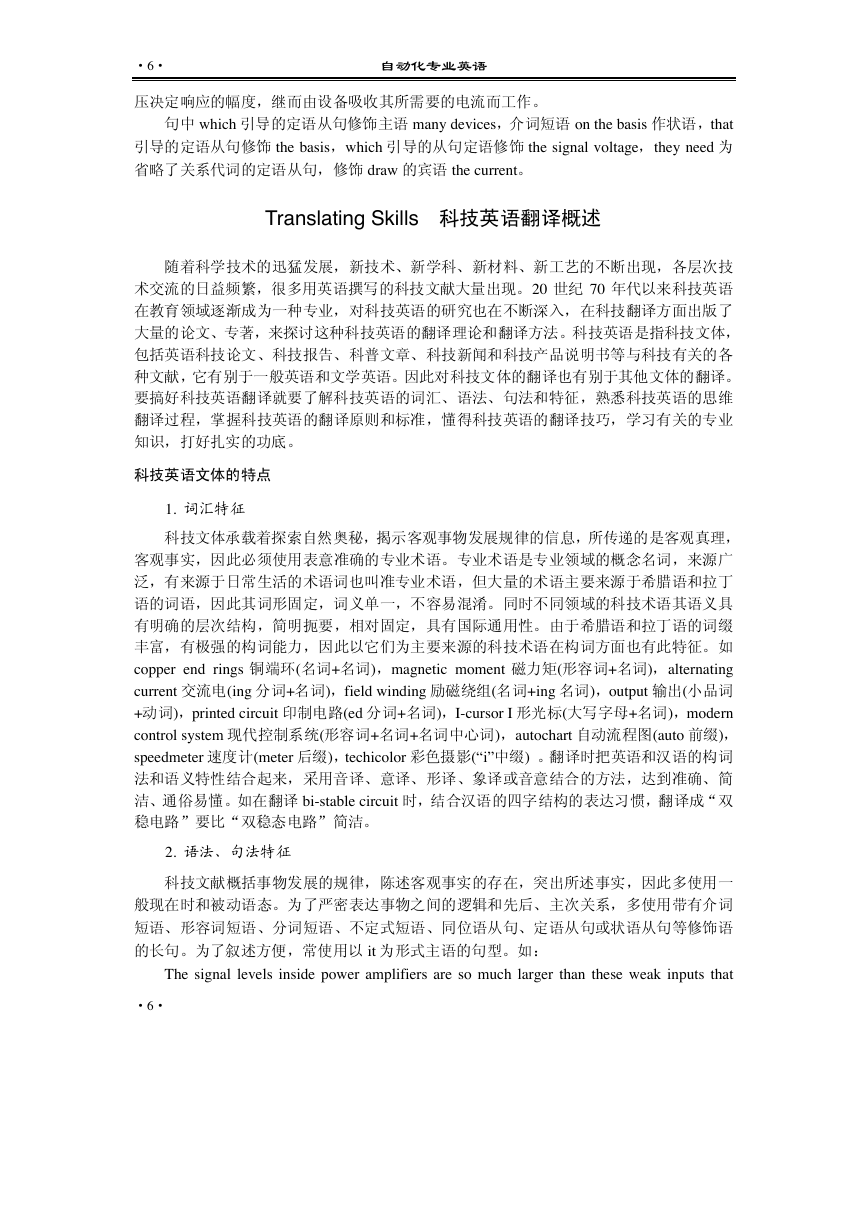
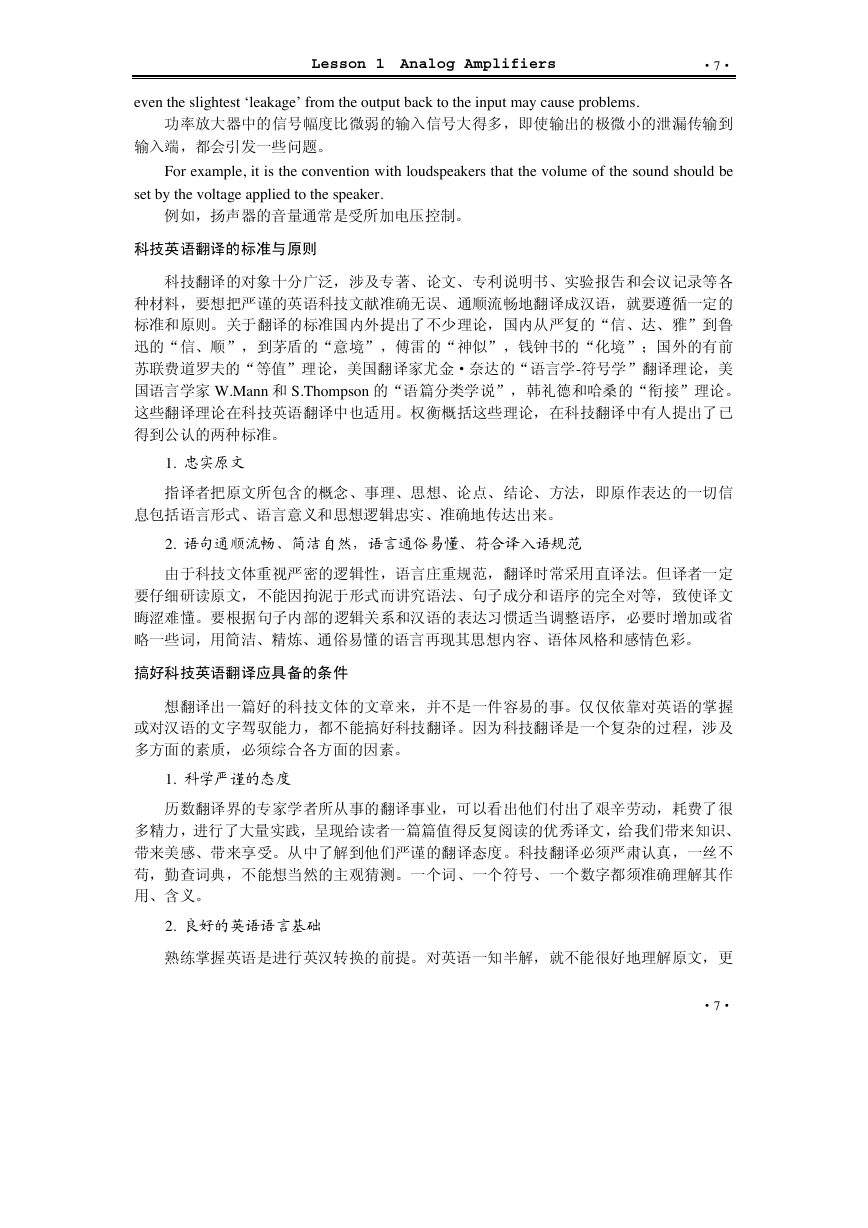









 2023年江西萍乡中考道德与法治真题及答案.doc
2023年江西萍乡中考道德与法治真题及答案.doc 2012年重庆南川中考生物真题及答案.doc
2012年重庆南川中考生物真题及答案.doc 2013年江西师范大学地理学综合及文艺理论基础考研真题.doc
2013年江西师范大学地理学综合及文艺理论基础考研真题.doc 2020年四川甘孜小升初语文真题及答案I卷.doc
2020年四川甘孜小升初语文真题及答案I卷.doc 2020年注册岩土工程师专业基础考试真题及答案.doc
2020年注册岩土工程师专业基础考试真题及答案.doc 2023-2024学年福建省厦门市九年级上学期数学月考试题及答案.doc
2023-2024学年福建省厦门市九年级上学期数学月考试题及答案.doc 2021-2022学年辽宁省沈阳市大东区九年级上学期语文期末试题及答案.doc
2021-2022学年辽宁省沈阳市大东区九年级上学期语文期末试题及答案.doc 2022-2023学年北京东城区初三第一学期物理期末试卷及答案.doc
2022-2023学年北京东城区初三第一学期物理期末试卷及答案.doc 2018上半年江西教师资格初中地理学科知识与教学能力真题及答案.doc
2018上半年江西教师资格初中地理学科知识与教学能力真题及答案.doc 2012年河北国家公务员申论考试真题及答案-省级.doc
2012年河北国家公务员申论考试真题及答案-省级.doc 2020-2021学年江苏省扬州市江都区邵樊片九年级上学期数学第一次质量检测试题及答案.doc
2020-2021学年江苏省扬州市江都区邵樊片九年级上学期数学第一次质量检测试题及答案.doc 2022下半年黑龙江教师资格证中学综合素质真题及答案.doc
2022下半年黑龙江教师资格证中学综合素质真题及答案.doc